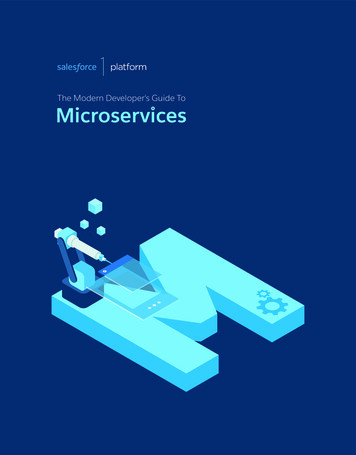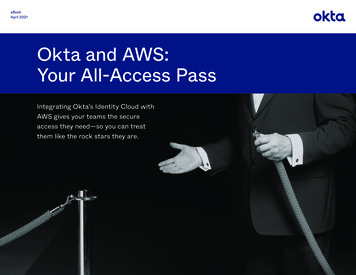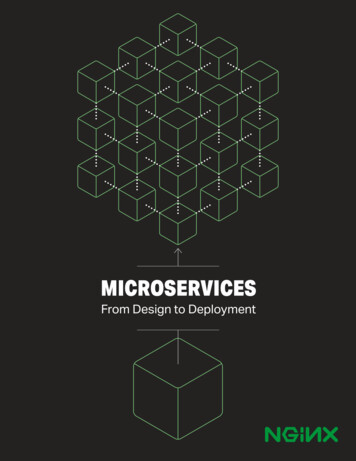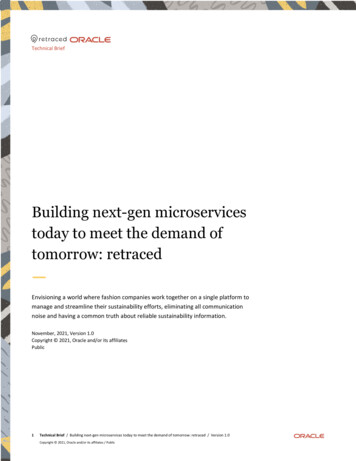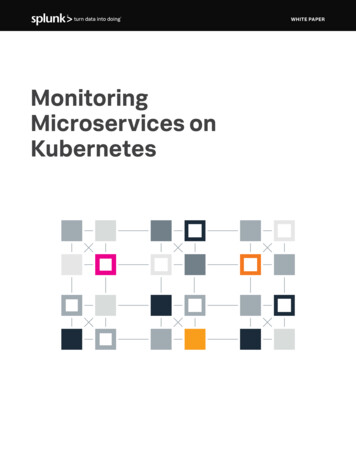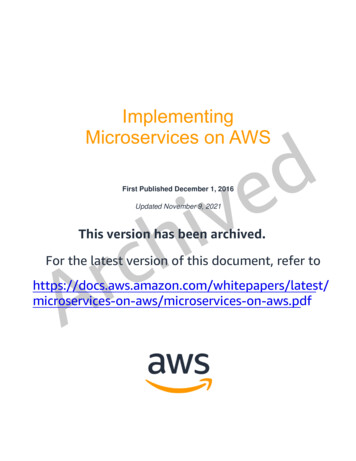
Transcription
ImplementingMicroservices on AWSAWS Whitepaper
Implementing Microservices on AWS AWS WhitepaperImplementing Microservices on AWS: AWS WhitepaperCopyright Amazon Web Services, Inc. and/or its affiliates. All rights reserved.Amazon's trademarks and trade dress may not be used in connection with any product or service that is notAmazon's, in any manner that is likely to cause confusion among customers, or in any manner that disparages ordiscredits Amazon. All other trademarks not owned by Amazon are the property of their respective owners, who mayor may not be affiliated with, connected to, or sponsored by Amazon.
Implementing Microservices on AWS AWS WhitepaperTable of ContentsAbstract and introduction . iAbstract . 1Are you Well-Architected? . 1Introduction . 1Microservices architecture on AWS . 3User interface . 3Microservices . 4Microservices implementation . 4Private links . 5Data store . 5Reducing operational complexity . 7API implementation . 7Serverless microservices . 8Disaster recovery . 10High availability . 10Deploying Lambda-based applications . 10Distributed systems components . 12Service discovery . 12DNS-based service discovery . 12Third-party software . 13Service meshes . 13Distributed data management . 13Configuration management . 15Asynchronous communication and lightweight messaging . 16REST-based communication . 16Asynchronous messaging and event passing . 16Orchestration and state management . 17Distributed monitoring . 19Monitoring . 20Centralizing logs . 20Distributed tracing . 21Options for log analysis on AWS . 22Chattiness . 25Auditing . 25Conclusion . 28Resources . 29Document history and contributors . 30Document History . 30Contributors . 30Notices . 32iii
Implementing Microservices on AWS AWS WhitepaperAbstractImplementing Microservices on AWSPublication date: November 9, 2021 (Document history and contributors (p. 30))AbstractMicroservices are an architectural and organizational approach to software development created tospeed up deployment cycles, foster innovation and ownership, improve maintainability and scalabilityof software applications, and scale organizations delivering software and services by using an agileapproach that helps teams work independently. With a microservices approach, software is composed ofsmall services that communicate over well-defined application programming interfaces (APIs) that canbe deployed independently. These services are owned by small autonomous teams. This agile approach iskey to successfully scale your organization.Three common patterns have been observed when AWS customers build microservices: API driven,event driven, and data streaming. This whitepaper introduces all three approaches and summarizes thecommon characteristics of microservices, discusses the main challenges of building microservices, anddescribes how product teams can use Amazon Web Services (AWS) to overcome these challenges.Due to the rather involved nature of various topics discussed in this whitepaper, including data store,asynchronous communication, and service discovery, it is recommended that you consider specificrequirements and use cases of their applications, in addition to the provided guidance, prior to makingarchitectural choices.Are you Well-Architected?The AWS Well-Architected Framework helps you understand the pros and cons of the decisions you makewhen building systems in the cloud. The six pillars of the Framework allow you to learn architectural bestpractices for designing and operating reliable, secure, efficient, cost-effective, and sustainable systems.Using the AWS Well-Architected Tool, available at no charge in the AWS Management Console, you canreview your workloads against these best practices by answering a set of questions for each pillar.For more expert guidance and best practices for your cloud architecture—reference architecturedeployments, diagrams, and whitepapers—refer to the AWS Architecture Center.IntroductionMicroservices architectures are not a completely new approach to software engineering, but rather acombination of various successful and proven concepts such as: Agile software development Service-oriented architectures API-first design Continuous integration/continuous delivery (CI/CD)In many cases, design patterns of the Twelve-Factor App are used for microservices.1
Implementing Microservices on AWS AWS WhitepaperIntroductionThis whitepaper first describes different aspects of a highly scalable, fault-tolerant microservicesarchitecture (user interface, microservices implementation, and data store) and how to build it on AWSusing container technologies. It then recommends the AWS services for implementing a typical serverlessmicroservices architecture to reduce operational complexity.Serverless is defined as an operational model by the following tenets: No infrastructure to provision or manage Automatically scaling by unit of consumption Pay for value billing model Built-in availability and fault toleranceFinally, this whitepaper covers the overall system and discusses the cross-service aspects of amicroservices architecture, such as distributed monitoring and auditing, data consistency, andasynchronous communication.This whitepaper only focuses on workloads running in the AWS Cloud. It doesn’t cover hybrid scenariosor migration strategies. For more information about migration, refer to the Container MigrationMethodology whitepaper).2
Implementing Microservices on AWS AWS WhitepaperUser interfaceMicroservices architecture on AWSTypical monolithic applications are built using different layers—a user interface (UI) layer, a businesslayer, and a persistence layer. A central idea of a microservices architecture is to split functionalities intocohesive verticals — not by technological layers, but by implementing a specific domain. The followingfigure depicts a reference architecture for a typical microservices application on AWS.Typical microservices application on AWSTopics User interface (p. 3) Microservices (p. 4) Data store (p. 5)User interfaceModern web applications often use JavaScript frameworks to implement a single-page application thatcommunicates with a representational state transfer (REST) or RESTful API. Static web content can beserved using Amazon Simple Storage Service (Amazon S3) and Amazon CloudFront.3
Implementing Microservices on AWS AWS WhitepaperMicroservicesBecause clients of a microservice are served from the closest edge location and get responses either froma cache or a proxy server with optimized connections to the origin, latencies can be significantly reduced.However, microservices running close to each other don’t benefit from a content delivery network. Insome cases, this approach might actually add additional latency. A best practice is to implement othercaching mechanisms to reduce chattiness and minimize latencies. For more information, refer to the thesection called “Chattiness” (p. 25) topic).MicroservicesAPIs are the front door of microservices, which means that APIs serve as the entry point for applicationslogic behind a set of programmatic interfaces, typically a RESTful web services API. This API accepts andprocesses calls from clients, and might implement functionality such as traffic management, requestfiltering, routing, caching, authentication, and authorization.Microservices implementationAWS has integrated building blocks that support the development of microservices. Two popularapproaches are using AWS Lambda and Docker containers with AWS Fargate.With AWS Lambda, you upload your code and let Lambda take care of everything required to run andscale the implementation to meet your actual demand curve with high availability. No administrationof infrastructure is needed. Lambda supports several programming languages and can be invokedfrom other AWS services or be called directly from any web or mobile application. One of the biggestadvantages of AWS Lambda is that you can move quickly: you can focus on your business logic becausesecurity and scaling are managed by AWS. Lambda’s opinionated approach drives the scalable platform.A common approach to reduce operational efforts for deployment is container-based deployment.Container technologies like Docker have increased in popularity in the last few years due to benefitslike portability, productivity, and efficiency. The learning curve with containers can be steep and youhave to think about security fixes for your Docker images and monitoring. Amazon Elastic ContainerService (Amazon ECS) and Amazon Elastic Kubernetes Service (Amazon EKS) eliminate the need toinstall, operate, and scale your own cluster management infrastructure. With API calls, you can launchand stop Docker-enabled applications, query the complete state of your cluster, and access many familiarfeatures like security groups, Load Balancing, Amazon Elastic Block Store (Amazon EBS) volumes, andAWS Identity and Access Management (IAM) roles.AWS Fargate is a serverless compute engine for containers that works with both Amazon ECS andAmazon EKS. With Fargate, you no longer have to worry about provisioning enough compute resourcesfor your container applications. Fargate can launch tens of thousands of containers and easily scale torun your most mission-critical applications.Amazon ECS supports container placement strategies and constraints to customize how Amazon ECSplaces and ends tasks. A task placement constraint is a rule that is considered during task placement. Youcan associate attributes, which are essentially key-value pairs, to your container instances and then use aconstraint to place tasks based on these attributes. For example, you can use constraints to place certainmicroservices based on instance type or instance capability, such as GPU-powered instances.Amazon EKS runs up-to-date versions of the open-source Kubernetes software, so you can use all theexisting plugins and tooling from the Kubernetes community. Applications running on Amazon EKS arefully compatible with applications running on any standard Kubernetes environment, whether running inon-premises data centers or public clouds. Amazon EKS integrates IAM with Kubernetes, enabling you toregister IAM entities with the native authentication system in Kubernetes. There is no need to manuallyset up credentials for authenticating with the Kubernetes control plane. The IAM integration enables youto use IAM to directly authenticate with the control plane itself and provide fine granular access to thepublic endpoint of your Kubernetes control plane.4
Implementing Microservices on AWS AWS WhitepaperPrivate linksDocker images used in Amazon ECS and Amazon EKS can be stored in Amazon Elastic Container Registry(Amazon ECR). Amazon ECR eliminates the need to operate and scale the infrastructure required topower your container registry.Continuous integration and continuous delivery (CI/CD) are best practices and a vital part of a DevOpsinitiative that enables rapid software changes while maintaining system stability and security. However,this is out of scope for this whitepaper. For more information, refer to the Practicing ContinuousIntegration and Continuous Delivery on AWS whitepaper.Private linksAWS PrivateLink is a highly available, scalable technology that enables you to privately connect yourvirtual private cloud (VPC) to supported AWS services, services hosted by other AWS accounts (VPCendpoint services), and supported AWS Marketplace partner services. You do not require an internetgateway, network address translation device, public IP address, AWS Direct Connect connection, or VPNconnection to communicate with the service. Traffic between your VPC and the service does not leavethe Amazon network.Private links are a great way to increase the isolation and security of microservices architecture. Amicroservice, for example, could be deployed in a totally separate VPC, fronted by a load balancer,and exposed to other microservices through a AWS PrivateLink endpoint. With this setup, using AWSPrivateLink , the network traffic to and from the microservice never traverses the public internet. Oneuse case for such isolation includes regulatory compliance for services handling sensitive data such asPCI, HIPPA and EU/US Privacy Shield. Additionally, AWS PrivateLink allows connecting microservicesacross different accounts and Amazon VPCs, with no need for firewall rules, path definitions, or routetables; simplifying network management. Utilizing PrivateLink, software as a service (SaaS) providers,and ISVs can offer their microservices-based solutions with complete operational isolation and secureaccess, as well.Data storeThe data store is used to persist data needed by the microservices. Popular stores for session data arein-memory caches such as Memcached or Redis. AWS offers both technologies as part of the managedAmazon ElastiCache service.Putting a cache between application servers and a database is a common mechanism for reducing theread load on the database, which, in turn, may allow resources to be used to support more writes. Cachescan also improve latency.Relational databases are still very popular to store structured data and business objects. AWS offers sixdatabase engines (Microsoft SQL Server, Oracle, MySQL, MariaDB, PostgreSQL, and Amazon Aurora) asmanaged services through Amazon Relational Database Service (Amazon RDS).Relational databases, however, are not designed for endless scale, which can make it difficult and timeintensive to apply techniques to support a high number of queries.NoSQL databases have been designed to favor scalability, performance, and availability over theconsistency of relational databases. One important element of NoSQL databases is that they typicallydon’t enforce a strict schema. Data is distributed over partitions that can be scaled horizontally and isretrieved using partition keys.Because individual microservices are designed to do one thing well, they typically have a simplifieddata model that might be well suited to NoSQL persistence. It is important to understand that NoSQLdatabases have different access patterns than relational databases. For example, it is not possible tojoin tables. If this is necessary, the logic has to be implemented in the application. You can use AmazonDynamoDB to create a database table that can store and retrieve any amount of data and serve any level5
Implementing Microservices on AWS AWS WhitepaperData storeof request traffic. DynamoDB delivers single-digit millisecond performance, however, there are certainuse cases that require response times in microseconds. DynamoDB Accelerator (DAX) provides cachingcapabilities for accessing data.DynamoDB also offers an automatic scaling feature to dynamically adjust throughput capacity inresponse to actual traffic. However, there are cases where capacity planning is difficult or not possiblebecause of large activity spikes of short duration in your application. For such situations, DynamoDBprovides an on-demand option, which offers simple pay-per-request pricing. DynamoDB on-demand iscapable of serving thousands of requests per second instantly without capacity planning.6
Implementing Microservices on AWS AWS WhitepaperAPI implementationReducing operational complexityThe architecture previously described in this whitepaper is already using managed services, but AmazonElastic Compute Cloud (Amazon EC2) instances still need to be managed. The operational effortsneeded to run, maintain, and monitor microservices can be further reduced by using a fully serverlessarchitecture.Topics API implementation (p. 7) Serverless microservices (p. 8) Disaster recovery (p. 10) High availability (p. 10) Deploying Lambda-based applications (p. 10)API implementationArchitecting, deploying, monitoring, continuously improving, and maintaining an API can be a timeconsuming task. Sometimes different versions of APIs need to be run to assure backward compatibilityfor all clients. The different stages of the development cycle (for example, development, testing, andproduction) further multiply operational efforts.Authorization is a critical feature for all APIs, but it is usually complex to build and involves repetitivework. When an API is published and becomes successful, the next challenge is to manage, monitor, andmonetize the ecosystem of third-party developers utilizing the APIs.Other important features and challenges include throttling requests to protect the backend services,caching API responses, handling request and response transformation, and generating API definitionsand documentation with tools such as Swagger.Amazon API Gateway addresses those challenges and reduces the operational complexity of creating andmaintaining RESTful APIs. API Gateway allows you to create your APIs programmatically by importingSwagger definitions, using either the AWS API or the AWS Management Console. API Gateway serves asa front door to any web application running on Amazon EC2, Amazon ECS, AWS Lambda, or in any onpremises environment. Basically, API Gateway allows you to run APIs without having to manage servers.The following figure illustrates how API Gateway handles API calls and interacts with other components.Requests from mobile devices, websites, or other backend services are routed to the closest CloudFrontPoint of Presence (PoP) to minimize latency and provide optimum user experience.7
Implementing Microservices on AWS AWS WhitepaperServerless microservicesAPI Gateway call flowServerless microservices“No server is easier to manage than no server”.Getting rid of servers is a great way to eliminate operational complexity.Lambda is tightly integrated with API Gateway. The ability to make synchronous calls from API Gatewayto Lambda enables the creation of fully serverless applications and is described in detail in the AmazonAPI Gateway Developer Guide.The following figure shows the architecture of a serverless microservice with AWS Lambda where thecomplete service is built out of managed services, which eliminates the architectural burden to designfor scale and high availability, and eliminates the operational efforts of running and monitoring themicroservice’s underlying infrastructure.8
Implementing Microservices on AWS AWS WhitepaperServerless microservicesServerless microservice using AWS LambdaA similar implementation that is also based on serverless services is shown in the following figure. In thisarchitecture, Docker containers are used with Fargate, so it’s not necessary to care about the underlyinginfrastructure. In addition to DynamoDB, Amazon Aurora Serverless is used, which is an on-demand,auto-scaling configuration for Amazon Aurora (MySQL‑compatible edition), where the database willautomatically start up, shut down, and scale capacity up or down based on your application's needs.9
Implementing Microservices on AWS AWS WhitepaperDisaster recoveryServerless microservice using FargateDisaster recoveryAs previously mentioned in the introduction of this whitepaper, typical microservices applications areimplemented using the Twelve-Factor Application patterns. The Processes section states that “Twelvefactor processes are stateless and share-nothing. Any data that needs to persist must be stored in astateful backing service, typically a database.”For a typical microservices architecture, this means that the main focus for disaster recovery should beon the downstream services that maintain the state of the application. For example, these can be filesystems, databases, or queues, for example. When creating a disaster recovery strategy, organizationsmost commonly plan for the recovery time objective and recovery point objective.Recovery time objective is the maximum acceptable delay between the interruption of service andrestoration of service. This objective determines what is considered an acceptable time window whenservice is unavailable and is defined by the organization.Recovery point objective is the maximum acceptable amount of time since the last data recovery point.This objective determines what is considered an acceptable loss of data between the last recovery pointand the interruption of service and is defined by the organization.For more information, refer to the Disaster Recovery of Workloads on AWS: Recovery in the Cloudwhitepaper.High availabilityThis section takes a closer look at high availability for different compute options.Amazon EKS runs Kubernetes control and data plane instances across multiple Availability Zones toensure high availability. Amazon EKS automatically detects and replaces unhealthy control planeinstances, and it provides automated version upgrades and patching for them. This control plane consistsof at least two API server nodes and three etcd nodes that run across three Availability Zones within aregion. Amazon EKS uses the architecture of AWS Regions to maintain high availability.Amazon ECR hosts images in a highly available and high-performance architecture, enabling you toreliably deploy images for container applications across Availability Zones. Amazon ECR works withAmazon EKS, Amazon ECS, and AWS Lambda, simplifying development to production workflow.Amazon ECS is a regional service that simplifies running containers in a highly available manner acrossmultiple Availability Zones within an AWS Region. Amazon ECS includes multiple scheduling strategiesthat place containers across your clusters based on your resource needs (for example, CPU or RAM) andavailability requirements.AWS Lambda runs your function in multiple Availability Zones to ensure that it is available to processevents in case of a service interruption in a single zone. If you configure your function to connect to avirtual private cloud (VPC) in your account, specify subnets in multiple Availability Zones to ensure highavailability.Deploying Lambda-based applicationsYou can use AWS CloudFormation to define, deploy, and configure serverless applications.10
Implementing Microservices on AWS AWS WhitepaperDeploying Lambda-based applicationsThe AWS Serverless Application Model (AWS SAM) is a convenient way to define serverless applications.AWS SAM is natively supported by AWS CloudFormation and defines a simplified syntax for expressingserverless resources. To deploy your application, specify the resources you need as part of yourapplication, along with their associated permissions policies in a AWS CloudFormation template, packageyour deployment artifacts, and deploy the template. Based on AWS SAM, SAM Local is an AWS CommandLine Interface (AWS CLI) tool that provides an environment for you to develop, test, and analyze yourserverless applications locally before uploading them to the Lambda runtime. You can use AWS SAMLocal to create a local testing environment that simulates the AWS runtime environment.11
Implementing Microservices on AWS AWS WhitepaperService discoveryDistributed systems componentsAfter looking at how AWS can solve challenges related to individual microservices, the focus moves tocross-service challenges, such as service discovery, data consistency, asynchronous communication, anddistributed monitoring and auditing.Topics Service discovery (p. 12) Distributed data management (p. 13) Configuration management (p. 15) Asynchronous communication and lightweight messaging (p. 16) Distributed monitoring (p. 19)Service discoveryOne of the primary challenges with microservices architectures is allowing services to discover andinteract with each other. The distributed characteristics of microservices architectures not only makeit harder for services to communicate, but also presents other challenges, such as checking the healthof those systems and announcing when new applications become available. You also must decide howand where to store meta-store information, such as configuration data, that can be used by applications.In this section several techniques for performing service discovery on AWS for microservices-basedarchitectures are explored.DNS-based service discoveryAmazon ECS now includes integrated service discovery that makes it easy for your containerized servicesto discover and connect with each other.Previously, to ensure that services were able to discover and connect with each other, you had toconfigure and run your own service discovery system based on Amazon Route 53, AWS Lambda, and ECSEvent Stream, or connect every service to a load balancer.Amazon ECS creates and manages a registry of service names using the Route 53 Auto Naming API.Names are automatically mapped to a set of DNS records so that you can refer to a service by name inyour code and write DNS queries to have the name resolve to the service’s endpoint at runtime. You canspecify health check conditions in a service's task definition and Amazon ECS ensures that only healthyservice endpoints are returned by a service lookup.In addition, you can also use unified service discovery for services managed by Kubernetes. To enable thisintegration, AWS contributed to the External DNS project, a Kubernetes incubator project.Another option is to use the capabilities of AWS Cloud Map. AWS Cloud Map extends the capabilitiesof the Auto Naming APIs by providing a service registry for resources, such as Internet Protocols (IPs),Uniform Resource Locators (URLs), and Amazon Resource Names (ARNs), and offering an API-basedservice discovery mechanism with a faster change propagation and the ability to use attributes tonarrow down the set of discovered resources. Existing Route 53 Auto Naming resources are upgradedautomatically to AWS Cloud Map.12
Implementing Microservices on AWS AWS Whitep
In many cases, design patterns of the Twelve-Factor App are used for microservices. This whitepaper first describes different aspects of a highly scalable, fault-tolerant microservices architecture (user interface, microservices implementation, and data store)
